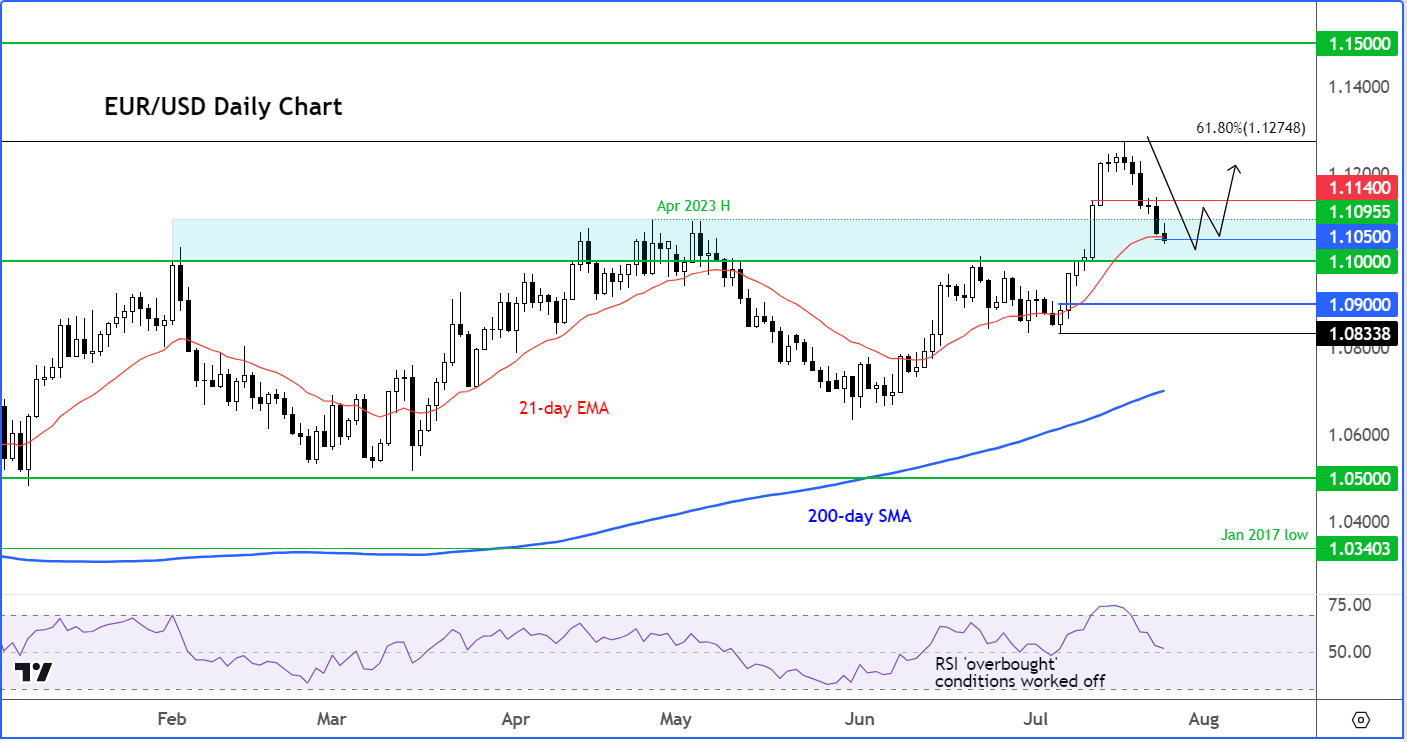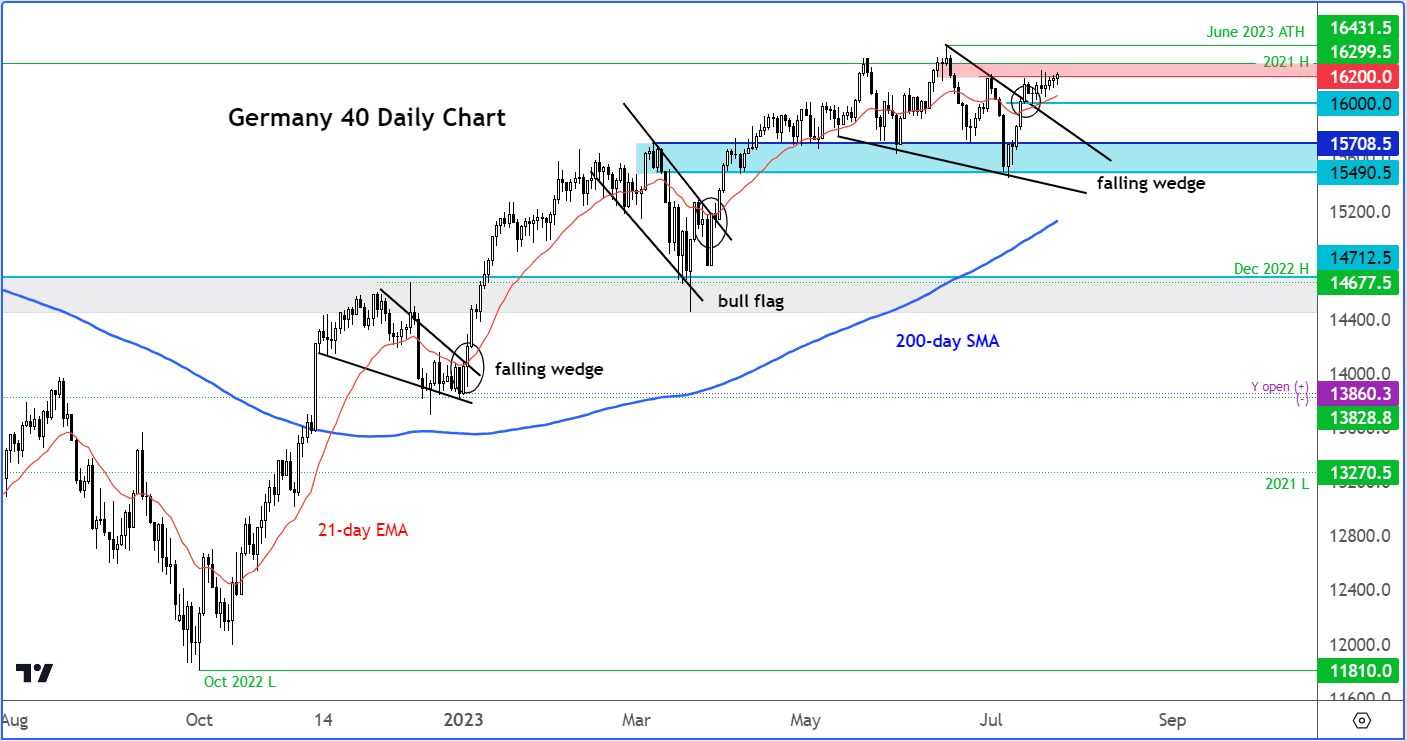
The near-term EUR/USD outlook hinges on the two major central bank decisions in as many days. First up, the Fed must decide whether to signal a pause for September after a likely 25 basis point rate hike on Wednesday, a signal that could have a major impact on the direction of the dollar. Once we know that, then all eyes will be on the ECB on Thursday. The latter could revert back to data-dependency, something which the markets have been pricing in with the EUR/USD falling over the past week and a half. If ECB President Christine Lagarde refuses to provide a strong hawkish signal for September, then this would be deemed a slightly dovish outlook, potentially keeping the euro under pressure and stock markets underpinned. But there’s the potential for the EUR/USD to rally anyway, should the Fed deliver a dovish surprise on Wednesday first. Meanwhile, with both the ECB and Fed likely to pause hikes soon, and China set to provide more support for its economy, the DAX outlook stays positive for now.
ECB set to deliver another 25bps hike
It has been roughly a year since the European Central Bank started its hiking cycle. But now the end of the tightening cycle is near. Up until last week, investors were confident that there will be at least two more rate increases to come from the ECB this year. However, following the recent releases of mostly weaker macro data, especially from Germany’s manufacturing sector (the so-called economic powerhouse of the Eurozone), and dovish comments from a couple of ECB officials, including Klaas Knot, who said that monetary tightening beyond Thursday’s meeting is not guaranteed, saw investors reduce bets for a September rate increase.
So, there is now a bit more uncertainty as to what happens beyond July, but we will have some clarity come Thursday. The ECB may be less inclined to offer guidance on the September meeting, although many analysts still see ECB rates peaking at 4%, meaning an additional hike beyond Thursday’s meeting is still largely expected.
It will be worth listening to the ECB President Christine Lagarde, who last time was very hawkish. If her tone is not too dissimilar, this could help lift the EUR/USD outlook. However, a lot will obviously depend on the Fed’s message the day before, on Wednesday. In any case, the ECB will not take any chances on inflation, and will be very careful in signalling any pivots from its current hawkish stance.
How will ECB decision impact EUR/USD outlook: Scenarios
My base case scenario: The most likely scenario is that the ECB will strike a balance in its policy decision on Thursday, one that would potentially keep the EUR/USD outlook mildly positive. Lagarde may hone in on the "higher for longer" narrative in order to counter speculation that the ECB will start cutting interest rates next year, when 75 basis points of cuts are priced in. But “higher for longer” may just mean a longer pause than further hikes. But it would probably keep the door wide open for a potential hike in September, rather than pre-committing to it in light of renewed weakness in Eurozone economy – especially in the manufacturing sector. In this scenario, I don’t think the EUR/USD will fall materially in terms of initial reaction and will likely remain around the 1.10 handle once the dust settles, before potentially resuming higher.
Dovish case: If the ECB signals that inflation could return to target sooner than expected because of a significant deterioration in the Eurozone’s economy, then the single currency could break sharply below the $1.10 handle. In our view, this scenario is less likely to be the case given how hawkish Lagarde was in the previous meeting just over a month ago.
Hawkish case: The ECB could point to core inflation remaining sticky and overlook recent signs of economic slowdown in the Eurozone. Like it did in June, the ECB pre-commit to another rate increase next month. In this scenario, the EUR/USD could rally towards 1.1300, above the recent 2023 high made last week.

EUR/USD outlook: Technical Analysis
Despite its recent pullback, the EUR/USD outlook remains bullish from a technical standpoint. This is because we haven’t yet seen a major topping pattern or a lower low to suggest the long-term bullish trend has ended.
If anything, the EUR/USD is now at a potentially important support zone, between 1.100 to 1.1095 region. Previously a ceiling on several occasions this year, we could see the EUR/USD rebound and push higher again from this area. Beyond this area, 1.0900 is the next big level – this being the base of the prior rally.
The line in the sand is at 1.0833 for me. This being the last low hit in early July, prior to the latest rally to a new 2023 high earlier last week. If we break below this level, then we will have created out first lower low. At that point, therefore, I would drop my bullish EUR/USD outlook.
Incidentally, last week’s high came right in around the 61.8% Fibonacci retracement level (1.1275) of the big downswing that started in January 2021. This level is now the key target for the bulls to claim. If they do so successfully, then there’s not many further resistances until 1.1500.
DAX outlook: Technical analysis
Despite all the cost-of-living crises, low economic activity and what not, stock market investors are looking forward to the end of central bank tightening and more Chinese stimulus. So, the DAX outlook remains bullish, especially as it continues to make higher highs and higher lows, along with the other European indices. After hitting a fresh record high in June, the pullback from there wasn’t too significant, which means the long-term trend is also still positive. The bulls will be happy for as long 16K support holds firm, keeping the German index above the 21-day exponential moving average. The index now needs to clear a key resistance band between 16,200 and 16,300 if it wants to climb to fresh uncharted territories soon.

Source for all charts used in this article: TradingView.com
-- Written by Fawad Razaqzada, Market Analyst
Follow Fawad on Twitter @Trader_F_R
How to trade with City Index
You can trade with City Index by following these four easy steps:
-
Open an account, or log in if you’re already a customer
• Open an account in the UK
• Open an account in Australia
• Open an account in Singapore
- Search for the company you want to trade in our award-winning platform
- Choose your position and size, and your stop and limit levels
- Place the trade










